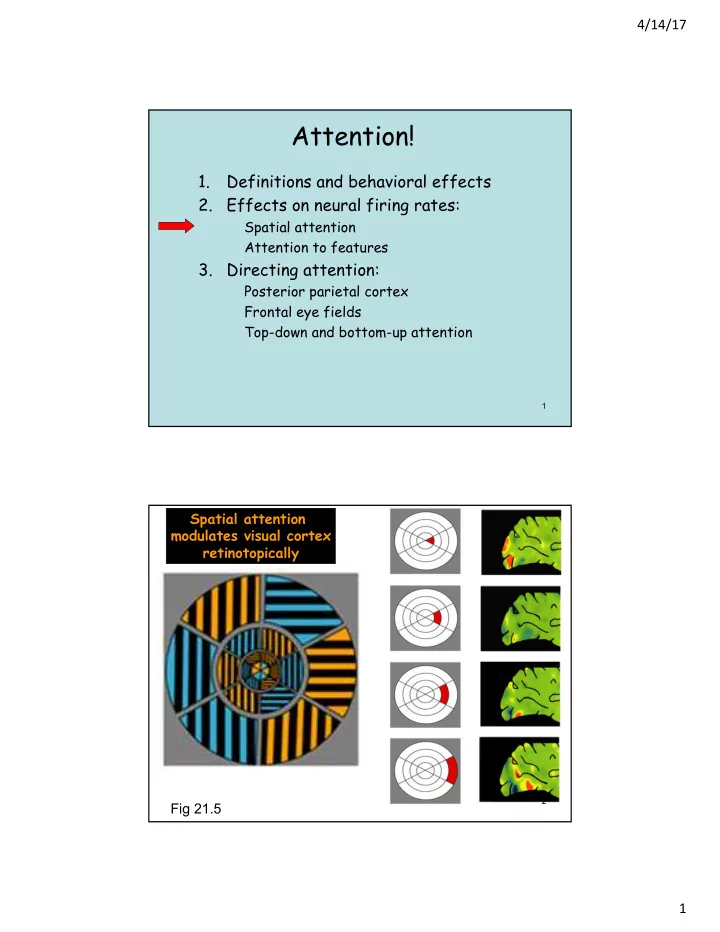

4/14/17 Attention! 1. Definitions and behavioral effects 2. Effects on neural firing rates: Spatial attention Attention to features 3. Directing attention: Posterior parietal cortex Frontal eye fields Top-down and bottom-up attention 1 Spatial attention modulates visual cortex retinotopically 2 Fig 21.5 1
4/14/17 Attention! 1. Definitions and behavioral effects 2. Effects on neural firing rates: Spatial attention—SPOTLIGHT Attention to features 3. Directing attention: Posterior parietal cortex Frontal eye fields Top-down and bottom-up attention 3 Attention to features: Shape, color, speed Same-different task A) Selective attention condition – Was a specific feature different? B) Divided attention condition – Was any feature different? 4 2
4/14/17 Subtract PET images: Selective – Divided to get regions associated with attention to a feature Blue = color V4 Green = speed Middle Temp. Orange = shape Inferior Temp. 5 6 3
4/14/17 How is attention directed? Who modulates V4, IT, MT...? 7 Attention! 1. Definitions and behavioral effects 2. Effects on neural firing rates: Spatial attention Attention to features 3. Directing attention: Posterior parietal cortex Frontal eye fields Top-down and bottom-up attention 8 4
4/14/17 Unilateral posterior parietal lesions cause unilateral neglect 9 10 5
4/14/17 Attention! 1. Definitions and behavioral effects 2. Effects on neural firing rates: Spatial attention Attention to features 3. Directing attention: Posterior parietal cortex Frontal eye fields Top-down and bottom-up attention 11 Supra-threshold electrical stimulation of FEF neurons causes eye-movement to those neurons’ motor field 12 6
4/14/17 Release lever if target spot dims Fig 21.13 13 Sub-threshold FEF microstimulation mimics behavioral effects of attention Bear Fig 21.13 14 7
4/14/17 FEF stimulation mimics physiological effects of attention Visual stimulus 15 Attention conclusions so far • Attention enhances detection and reaction times • Spatial attention turns up brain activation topographically • Feature attention turns up feature-specific areas • Frontal and posterior parietal areas are involved in directing attention 16 8
4/14/17 Attention! 1. Definitions and behavioral effects 2. Effects on neural firing rates: Spatial attention Attention to features 3. Directing attention: Posterior parietal cortex Frontal eye fields Top-down and bottom-up attention 17 Bottom-up Top-down • Stimulus-driven: • Goal-driven: salience, automatic voluntary, effortful • Feed-forward neural • Feed-back neural projections projections • Faster • Slower • e.g. • e.g. Loud noise, flash of light Looking for keys POPOUT! CONJUNCTION SEARCH 18 9
4/14/17 19 Task: saccade to target Salient, automatic = Bottom-up after delay Not salient = Top-down Red circle indicates eye position 20 10
4/14/17 Behavioral hallmarks of top-down vs. bottom-up attention Bottom-up faster Top-down slower and less sensitive to distractors and more sensitive to distractors (6 ms per additional) (22 ms per additional) 21 22 11
4/14/17 Attention conclusions • Attention enhances detection and reaction times • Spatial or feature attention can turn up the firing rates of relevant neurons or their synchronization • Top-down attention (search) engages frontal areas first, and emphasizes synchronization at lower frequencies (22-34 Hz) • Bottom-up attention (pop-out) engages posterior parietal cortex first, and emphasizes synchronization at higher frequencies (35-55 Hz) Attention, Binding, and Consciousness 1. Perceptual binding, dynamic binding 2. Neural Correlates of Consciousness: Binocular rivalry 3. Attention vs. consciousness 4. Binding revisited: Split-brain, split-consciousness 24 12
4/14/17 The Binding Problem “Exactly how the parallel streams of sensory data are melded into perception, images, and ideas remains the Holy Grail of neuroscience.” —Bear p. 421 25 Perceptual Binding Static Dynamic • Learned or innate • In order to be able to perceive and represent • Dedicated neurons i.e. (remember) new feature anatomical neural combinations, new objects or new situations • Distributed neurons Face Eyes Detected! top Mouth below 26 13
4/14/17 Treisman’s Feature Integration Theory (Lab 9 visual search) 27 Synthesized Dynamic binding by neural synchronization? “By momentarily synchronizing the fast oscillations generated by different regions of cortex, perhaps the brain binds together various neural components into a single perceptual construction . The evidence for this idea is indirect, far from proven, and understandably controversial.” —Bear p.592 28 14
4/14/17 Attention, Binding, and Consciousness 1. Perceptual binding, dynamic binding 2. Neural Correlates of Consciousness: Binocular rivalry 3. Attention vs. consciousness 4. Binding revisited: Split-brain, split-consciousness 29 Neural Correlates of Consciousness (NCC) The minimal neural activity sufficient for any one specific conscious percept. 30 15
4/14/17 32 16
4/14/17 Binocular rivalry Inferior temporal (IT) cortex neurons Sheinberg & Logothetis 1997 Inferior Temporal cortex 33 Superior temporal sulcus (STS) neuron 34 17
Recommend
More recommend